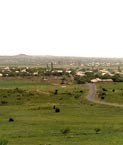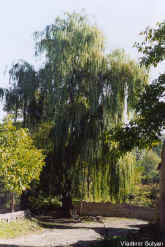|
|
|

|
Exiting
right
at
the
second
interchange at the turnoff for Byurakan from the
Gyumri highway, on the left is a birdís wing
monument
to the heroes of the battle for Van. The
monument is built on the site of the
Bronze Age graveyard of
Verin Naver, with substantial chamber tombs of coarse boulders
surrounded
by
stone
rings
and |
|
In
Byurakan
(has
Bed
&
Breakfast)
is
the important
S.
Hovhannes basilican church. About
1 km NE (ask directions) is the Artavazik
church of 7th c., with a 13th
c. khachkar.
In
the middle of the village, on the left side of the road to
Antarut are interesting
khachkars
and gravestones.
|

|
|
covered
with a
mound.
Taking
the
Byurakan exit but
continuing
past the turnoff for Byurakan, one
first
reaches
the village of Agarak,
on the Amberd river,
founded in 1919 from Van and
Tbilisi.
The village was
apparently
located on the site of an
Urartian
settlement.
Adjoining the
road on the left side as one ascends N toward the village, there is one
massive, well preserved wall of an earlier
building converted to use as
a church
(S.
Hovahnnes) possibly in the 5-6th c. through the addition of an
apse.
Not far from the church (ask directions in the
center) are S.
Gevorg shrine, Tukh Mannuk church foundations of the
10th
c.
and medieval cemetery (mostly occupied by modern one),
as well as ruined mosque of the
late Persian
period. On the SW side of the village, left from the main Gyumri
highway is situated a volcanic
plato, with ritual carvings, symbols and traces of a prehistoric observatory,
different building and fortification wall remains, occupied by
Eneolithic, Early Bronze Age through medieval period settlement
with remains of Hellenistic period building
walls, part of which is converted to a shrine by local
villagers.
|
|
|
 |
|
|
|